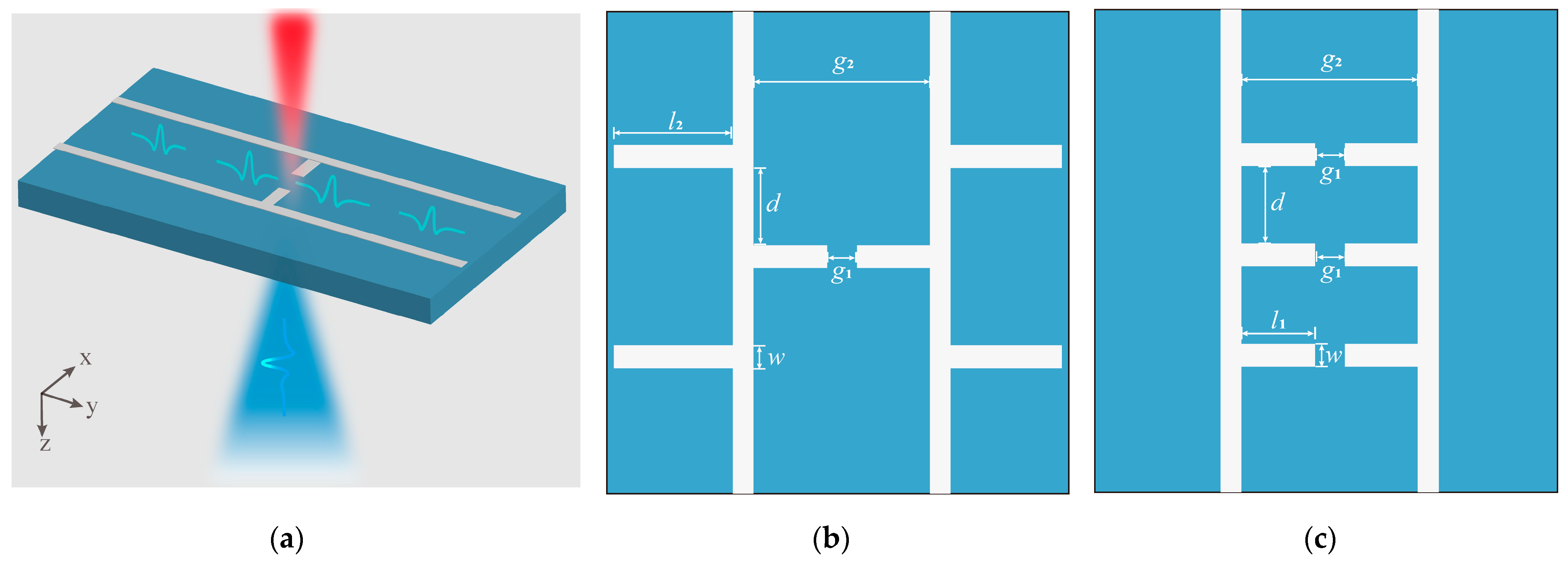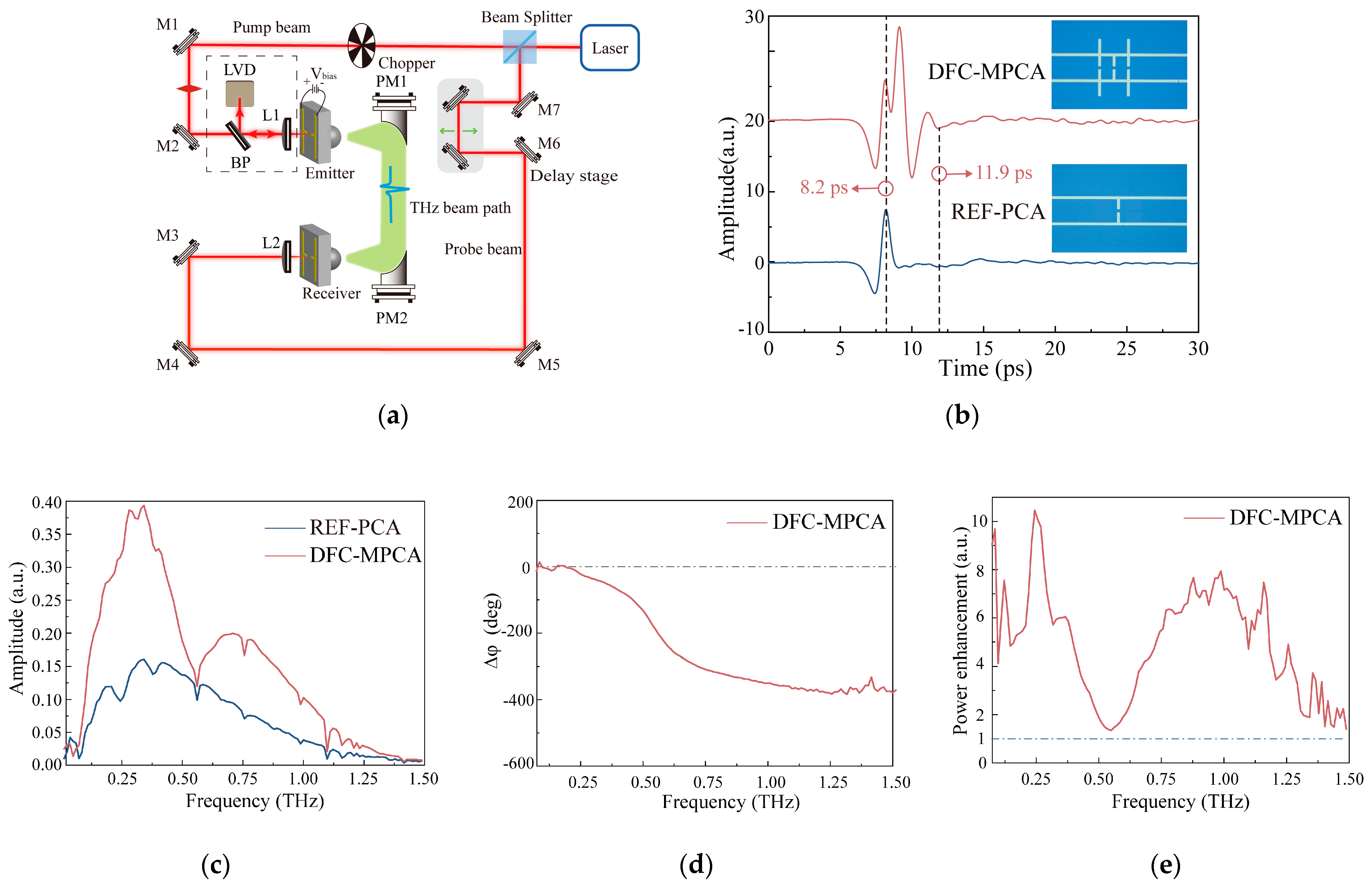Broadband Photoconductive Antenna with Enhanced Full-Band Radiation Power Based on Dual-Frequency Complementary Technology
Abstract
1. Introduction
2. Materials and Methods
2.1. Initial Design and Exploration
2.2. Design of Dual-Frequency Complementary Meta-Atomic Photoconductive Antenna (DFC-MPCA)
3. Results
4. Discussion
5. Conclusions
Author Contributions
Funding
Institutional Review Board Statement
Informed Consent Statement
Data Availability Statement
Conflicts of Interest
Abbreviations
| THz | Terahertz |
| PCA | Photoconductive antenna |
| CTL | Coplanar transmission line |
| DFC-MPCA | Dual-frequency complementary meta-atomic photoconductive antenna |
| THz-TDS | Terahertz time-domain spectroscopy |
References
- Auston, D.H.; Cheung, K.P.; Smith, P.R. Picosecond Photoconducting Hertzian Dipoles. Appl. Phys. Lett. 1984, 45, 284–286. [Google Scholar] [CrossRef]
- Preu, S.; Döhler, G.H.; Malzer, S.; Wang, L.J.; Gossard, A.C. Tunable, Continuous-Wave Terahertz Photomixer Sources and Applications. J. Appl. Phys. 2011, 109, 061301. [Google Scholar] [CrossRef]
- Burford, N.M.; El-Shenawee, M.O. Review of Terahertz Photoconductive Antenna Technology. Opt. Eng. 2017, 56, 010901. [Google Scholar] [CrossRef]
- Ashworth, P.C.; Pickwell-MacPherson, E.; Provenzano, E.; Pinder, S.E.; Purushotham, A.D.; Pepper, M.; Wallace, V.P. Terahertz Pulsed Spectroscopy of Freshly Excised Human Breast Cancer. Opt. Express 2009, 17, 12444–12454. [Google Scholar] [CrossRef] [PubMed]
- Jepsen, P.U.; Cooke, D.; Koch, M. Terahertz Spectroscopy and Imaging—Modern Techniques and Applications. Laser Photonics Rev. 2012, 6, 418, Erratum in Laser Photonics Rev. 2011, 5, 124–166. [Google Scholar] [CrossRef]
- Chen, H.T.; Padilla, W.J.; Zide, J.M.; Gossard, A.C.; Taylor, A.J.; Averitt, R.D. Active Terahertz Metamaterial Devices. Nature 2006, 444, 597–600. [Google Scholar] [CrossRef] [PubMed]
- Yachmenev, A.; Lavrukhin, D.; Glinskiy, I.; Zenchenko, N.; Goncharov, Y.; Spektor, I.; Khabibullin, R.; Otsuji, T.; Ponomarev, D. Metallic and Dielectric Metasurfaces in Photoconductive Terahertz Devices: A Review. Opt. Eng. 2019, 59, 061608. [Google Scholar] [CrossRef]
- Berry, C.W.; Wang, N.; Hashemi, M.R.; Unlu, M.; Jarrahi, M. Significant Performance Enhancement in Photoconductive Terahertz Optoelectronics by Incorporating Plasmonic Contact Electrodes. Nat. Commun. 2013, 4, 1622. [Google Scholar] [CrossRef] [PubMed]
- Yang, S.H.; Hashemi, M.R.; Berry, C.W.; Jarrahi, M. 7.5% Optical-to-Terahertz Conversion Efficiency Offered by Photoconductive Emitters With Three-Dimensional Plasmonic Contact Electrodes. IEEE Trans. Terahertz Sci. Technol. 2014, 4, 575–581. [Google Scholar] [CrossRef]
- Bashirpour, M.; Poursafar, J.; Kolahdouz, M.; Hajari, M.; Forouzmehr, M.; Neshat, M.; Hajihoseini, H.; Fathipour, M.; Kolahdouz, Z.; Zhang, G. Terahertz Radiation Enhancement in Dipole Photoconductive Antenna on LT-GaAs Using a Gold Plasmonic Nanodisk Array. Opt. Laser Technol. 2019, 120, 105726. [Google Scholar] [CrossRef]
- Park, S.-G.; Jin, K.H.; Yi, M.; Ye, J.C.; Ahn, J.; Jeong, K.H. Enhancement of Terahertz Pulse Emission by Optical Nanoantenna. ACS Nano 2012, 6, 2026–2031. [Google Scholar] [CrossRef] [PubMed]
- Park, S.-G.; Choi, Y.; Oh, Y.-J.; Jeong, K.-H. Terahertz Photoconductive Antenna With Metal Nanoislands. Opt. Express 2012, 20, 25530–25535. [Google Scholar] [CrossRef] [PubMed]
- Bashirpour, M.; Forouzmehr, M.; Hosseininejad, S.E.; Kolahdouz, M.; Neshat, M. Improvement of Terahertz Photoconductive Antenna Using Optical Antenna Array of ZnO Nanorods. Sci. Rep. 2019, 9, 1–8. [Google Scholar] [CrossRef] [PubMed]
- Wang, K.; Gu, J.; Shi, W.; An, Y.; Li, Y.; Tian, Z.; Ouyang, C.; Han, J.; Zhang, W.; Zhen, T. All-Dielectric Nanograting for Increasing Terahertz Radiation Power of Photoconductive Antennas. Opt. Express 2020, 28, 19144–19151. [Google Scholar] [CrossRef] [PubMed]
- O’Hara, J.F.; Chen, H.; Taylor, A.J.; Averitt, R.D.; Padilla, W.J. Split-Ring Resonator Enhanced Terahertz Antenna. In Proceedings of the Nonlinear Optics: Materials, Fundamentals and Applications, Washington, DC, USA; 2007. [Google Scholar] [CrossRef]
- Shi, X.; Wang, K.; Gu, J.; An, Y.; Jia, R.; Tian, Z.; Ouyang, C.; Han, J.; Zhang, W. Photoconductive Meta-Antenna Enabling Terahertz Amplitude Spectrum Manipulation. Adv. Photon. Res. 2020, 2, 2000036. [Google Scholar] [CrossRef]
- Wang, C.; Zhang, Z.; Zhang, Y.; Xie, X.; Yang, Y.; Han, J.; Li, E.; Chen, H.; Gu, J.; Sha, W.E.; et al. Enhancing Directivity of Terahertz Photoconductive Antennas Using Spoof Surface Plasmon Structure. New J. Phys. 2022, 24, 073046. [Google Scholar] [CrossRef]








| Method | Materials | Total Gain | Enhancement Effect | Radiation Bandwidth | Spectral Modulation | Manufacturing difficulty |
|---|---|---|---|---|---|---|
| Nano-grating [14] | GaAs | 3.92 | Overall | 0.05–1.6 THz | No | Difficult |
| Micron-scale SRRs [15] | Gold | 3 | Partial | 0.02–2 THz | Yes | Easy |
| Micron-scale SRRs [16] | Gold | 1.55 | Partial | 0.05–1.3 THz | Yes | Easy |
| Nano-grating [11] | Gold | 2.27 | Overall | 0.1–1.1 THz | No | Difficult |
| Nano-island [12] | Silver | 2 | Overall | N. A. | No | Middle |
| Nanorod [13] | ZnO | 4 | Overall | N. A. | No | Difficult |
| Micron-scale SSPP [17] | Gold | N. A. | Partial | N. A. | N. A. | Easy |
| This work | Gold | 4.5 | Overall | 0.02–1.5 THz | Yes | Easy |
Disclaimer/Publisher’s Note: The statements, opinions and data contained in all publications are solely those of the individual author(s) and contributor(s) and not of MDPI and/or the editor(s). MDPI and/or the editor(s) disclaim responsibility for any injury to people or property resulting from any ideas, methods, instructions or products referred to in the content. |
© 2025 by the authors. Licensee MDPI, Basel, Switzerland. This article is an open access article distributed under the terms and conditions of the Creative Commons Attribution (CC BY) license (https://creativecommons.org/licenses/by/4.0/).
Share and Cite
Sun, D.; Zhang, Q.; Gao, D.; Wang, Q. Broadband Photoconductive Antenna with Enhanced Full-Band Radiation Power Based on Dual-Frequency Complementary Technology. Electronics 2025, 14, 3919. https://doi.org/10.3390/electronics14193919
Sun D, Zhang Q, Gao D, Wang Q. Broadband Photoconductive Antenna with Enhanced Full-Band Radiation Power Based on Dual-Frequency Complementary Technology. Electronics. 2025; 14(19):3919. https://doi.org/10.3390/electronics14193919
Chicago/Turabian StyleSun, Donglin, Qingdong Zhang, Di Gao, and Qipeng Wang. 2025. "Broadband Photoconductive Antenna with Enhanced Full-Band Radiation Power Based on Dual-Frequency Complementary Technology" Electronics 14, no. 19: 3919. https://doi.org/10.3390/electronics14193919
APA StyleSun, D., Zhang, Q., Gao, D., & Wang, Q. (2025). Broadband Photoconductive Antenna with Enhanced Full-Band Radiation Power Based on Dual-Frequency Complementary Technology. Electronics, 14(19), 3919. https://doi.org/10.3390/electronics14193919






